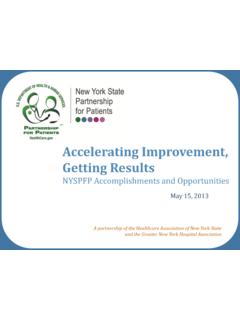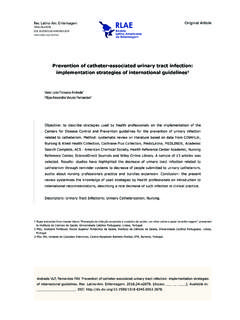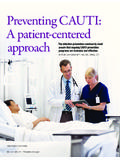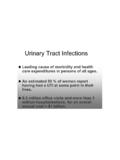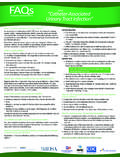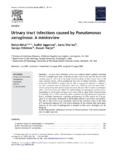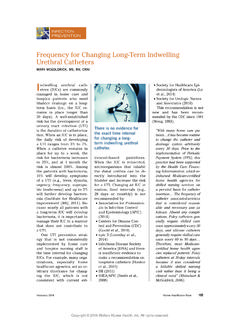Transcription of CAUTI and CLABSI Initiatives - NYSPFP
1 A partnership of the Healthcare Association of New York State and the Greater New York Hospital AssociationMay 24, 2012 CAUTI and CLABSI InitiativesNYS PARTNERSHIP FOR PATIENTSO bjectivesoNYSPFP BackgroundoWhy focus on CAUTIs and CLABSIs?oOverview of the CAUTI and CLABSI InitiativesoGoalsoObjectivesoInsertion and Maintenance BundlesoMeasurement strategy/data collectionoInterdisciplinary teamoAdded benefit to participation in NYSPFP CAUTI / CLABSI InitiativesoPoint prevalence studyoCAUTI and CLABSI assessments of current practiceoCAUTI and CLABSI team planning oNext steps and additional resources2 NYSPFP Background3 NYS PARTNERSHIP FOR PATIENTST imeline for Implementation of HAI InitiativesCAUTI and CLABSIVAP and SSIoJune 2012 February 2013oHospitals begin 6-month implementation periodoInitial educational Webinar seriesoTechnical SupportoFebruary April 2013oTargeted education, based on implementation experience and hospital needs supporting hospital-wide spreadoApril November 2013oOngoing.
2 Sustained project management support and technical assistanceoFall/Early WinteroVAP measurement educationoNovember 2012oKick-off of VAP and SSI initiatives4 NYS PARTNERSHIP FOR PATIENTSF actors Contributing to the Overall DesignoThe Joint Commission oNational Patient Safety Goal ( CAUTI ) and ( CLABSI ) oCMS oValue-based purchasingoInpatient Quality Reporting ProgramoNYSPFP Infection Prevention Clinical Workgroup o16 membersoConsensus model to develop CAUTI and CLABSI program design and measurement strategyoInput from you5 catheter - associated urinary tract Infection ( CAUTI ) initiative David Calfee, MD, MSNew York-Presbyterian Hospital/Weill Cornell Medical Center and Co-Chair, NYSPFP Infection Prevention Clinical Workgroup6 NYS PARTNERSHIP FOR PATIENTSAre you doing hospital-wide surveillance of CAUTIs? don t know7 NYS PARTNERSHIP FOR PATIENTSWhy focus on CAUTIs?oAbout 40% of all nosocomial infections are CAUTIs1o80% of healthcare- associated UTIs are caused by a urinary catheteroMore than 500,000 patients suffer from CAUTIs annually, costing hospitals an estimated $400 milliono5% of all deaths from healthcare- associated infections are associated with urinary cathetersoAccording to one study, about 40% of patients with a urinary catheter experienced at least 1 inappropriate catheter -day and 31% of the urinary catheter -days were inappropriate21 Haley RW, et al.
3 The Nationwide Nosocomial Infection Rate: A New Need for Vital Statistics. Am J Epidemiol 1985; 121 MM, et al. Inappropriate Use of urinary Catheters: A Prospective Observational Study. Am J Infection Control 2012; 40 PARTNERSHIP FOR PATIENTSCAUTI is PreventableoProper management and use of catheters could prevent infectionso65-75% of CAUTIs may be preventable*oCAUTIs may be the most preventable HAI**Umscheid C. Infect Control Hosp Epidemiol 2011;32:101-149 NYS PARTNERSHIP FOR PATIENTSCAUTI initiative GoalsoTo reduce unnecessary catheter utilizationoTo eliminate and sustain reductions in catheter - associated urinary tract infectionsoElimination of HAIs has been defined as maximal reduction of the incidence of infection in a defined geographical area as a result of deliberate efforts; continued measures to prevent reestablishment of transmission are required. * *Cardo D.
4 Infect Control Hosp Epidemiol 2010;31:1101-510 NYS PARTNERSHIP FOR PATIENTSCAUTI initiative Objectives*ED data will not be included in the denominator. **Participants would be expected to implement the CAUTI Bundle of Interventions throughout the hospital, but would only be required to submit data for the initial two units and two additional units, for a total of four units. 11oSpread the CAUTI Insertion and Maintenance Bundleshospital-wide**oReduce catheter utilization hospital-wideby 15%oReduce CAUTIs by 40%or achieve a SIR of November 2013oReduce catheter utilization in one high-utilization ICU by at least 10%oEstablish baseline CAUTI and catheter utilization data in at least one high-utilization non-ICU unitoReduce catheter utilization in the ED*oReduce CAUTIs in the high-utilization ICU by 20%or achieve a standardized infection ratio (SIR) of lessWithin First 6 MonthsoImplement the CAUTI Bundles: 1)In at least one high-utilization adult ICU, and2)In at least one high-utilization non-ICU unit3)In the Emergency Department (ED)By June 2012 NYS PARTNERSHIP FOR PATIENTSCAUTI Improvement BundlesStage 1- Appropriate Use and InsertionStage 2 catheter MaintenanceoAvoid unnecessary urinary catheters.
5 Insert urinary catheters in the presence of an appropriate indication:oPeri-operative use for selected surgical proceduresoUrine output monitoring in critically ill patientsoManaging acute urinary retention and urinary obstructionoAssisting with pressure ulcer healing for incontinent patientsoAs an exception, at patient request to improve comfortoInsert urinary catheters using aseptic technique ( catheter insertion kits)oMaintain urinary catheters based on recommended guidelines:oTamper-evident seal is intactoCollection bag is not on the flooroCollection bag is secured to the legoEvery patient with a catheter has a labeled urine collection container at the bedsideoReview urinary catheter necessity daily and remove promptly12 NYS PARTNERSHIP FOR PATIENTSCAUTI initiative MeasurementoMonthly data collectionoIndwelling catheter days (NHSN)oCAUTI events in the intervention ICU(s) and non-ICU unit(s)oDocumentation of appropriate indication for urinary catheter , assessed at least one day per # of patients on unit with urinary catheter for which there is appropriate indication / # of patients on unit with urinary catheteroMonthly calculations using data collectedoDevice utilization ratio (NHSN)oCAUTI rate in the ICU and non-ICU unit (NHSN)
6 OSIR for CAUTIoBaseline and follow-up assessments to determine diffusion of the Bundles13 Central Line- associated Bloodstream Infections ( CLABSI ) InitiativeGhinwa Dumyati, MDUniversity of Rochester Medical Center and Co-Chair, NYSPFP Infection Prevention Clinical Workgroup 14 NYS PARTNERSHIP FOR PATIENTSAre you doing hospital-wide surveillance of CLABSIs? don t know15 NYS PARTNERSHIP FOR PATIENTSWhy focus on CLABSIs?oNearly 250,000 CLABSI cases occur in hospitals1oIn ICUs, up to 28,000 patients die from CLABSIs annually2oAccording to the CDC Vital Signs March 2011 Issue: oAbout 41,000 bloodstream infections occur in hospital patients with central lines annuallyo58% fewer bloodstream infections occurred in hospital ICU patients with central lines in 2009 than in 2001: decreased from 43,000 to 18,000oIn 2009: About 23,000 CLABSI occurred outside the ICUoIn 2009 alone, reducing infections saved about 3,000-6,000 lives and about $414 million in extra medical costs compared with 2001oAt this point, the burden on CLABSI is outside the ICU1 Centers for Disease Control and Protection, Morbidity and Mortality Weekly Report, October 14, 2005 / 54(40);1013-1016: , et al.
7 : Eliminating catheter -related bloodstream infections in the intensive care unit. Crit Care Med 32:2014 2020, Oct. PARTNERSHIP FOR PATIENTSCLABSI is PreventableoPrevention focuses on:oInsertionoMaintenanceoRemoval17 NYS PARTNERSHIP FOR PATIENTSCLABSI initiative GoaloTo eliminate central line associated bloodstream infections 18 NYS PARTNERSHIP FOR PATIENTSCLABSI initiative Objectives*Participants would be expected to implement the CLABSI Bundle of interventions throughout the hospital, but would only be required to submit data for the initial two units and two additional units, for a total of four units. 19oSpread the CLABSI Insertion and Maintenance Bundleshospital-wide*oReduce CLABSIs by 50%or achieve a SIR of or less hospital-wideBy November 2013oReduce CLABSIs in the adult ICU setting by 30%or achieve a SIR of or lessoEstablish a baseline in at least one adult non-ICU unitWithin First 6 MonthsoImplement the CLABSI Insertion Bundlein the adult ICU settingoImplement the CLABSI Maintenance Bundle in at least one high-utilization adult ICU and at least one high-utilization adult non-ICU unitBy June 2012 NYS PARTNERSHIP FOR PATIENTSCLABSI Improvement BundlesCLABSI Insertion BundleCLABSI Maintenance Bundle20oPerform hand hygieneoEnsure maximal sterile barrier precautionsoApply chlorhexidine skin antisepsisoSelect an optimal catheter insertion site.
8 Avoiding the femoral vein for central venous access in adult patients whenever possibleoReview line necessity daily and promptly remove unnecessary linesoPerform hand hygieneoProper dressing changeoAseptic technique for accessing and changing needleless access deviceoStandardize tubing changeoReview line necessity daily and promptly remove unnecessary linesNYS PARTNERSHIP FOR PATIENTSCLABSI initiative MeasurementoMonthly data collectionoCentral line days (NHSN)oNumber of CLABSI events (NHSN)oDocumentation of review of line necessity, assessed at least one day per weeko# of patients on unit with central line for which there is documented review of line necessity / # of patients on unit with central lineoMonthly calculations using data collectedoCLABSI rate (NHSN)oSIR for CLABSIoBaseline and follow-up assessments to determine diffusion of the Bundles21 NYS PARTNERSHIP FOR PATIENTSE vidence for Central Line Necessity Process Measure FocusoEach day a central line is in place increases the risk of a CLABSIoAcademic medical center study of idle central venous catheters (CVC) outside of the ICU setting1oPICC lines retain longer than other CVCs and are used for sequential days of IV access alone, when a peripheral intravenous catheter might suffice oOutside of the ICU setting, significant CVC days were unjustified oReduction in idle CVC days could potentially reduce CLABSI risk oHospital-wide survey on CVC use2oUnnecessary catheter days were higher in non-ICU settings compared to ICUoIn the non-ICU setting, 8% of the time, nurses and treating physicians could not justify why the catheter was in place1 Tejedor SC, et al.
9 Temporary Central Venous catheter Utilization Patterns in a Large Tertiary Care Center: Tracking the Idle Central Venous catheter . Infection Control and Hospital Epidemiology 2012; 33: W, et al. Hospital-wide Survey of the Use of Central Venous Catheters. Journal of Hospital Infection 2011; 77: PARTNERSHIP FOR PATIENTSWho is on your interdisciplinary team to reduce CAUTIs? (Check all that apply) on the on the leadership PARTNERSHIP FOR PATIENTSWho is on your interdisciplinary team to reduce CLABSIs? (Check all that apply) on the on the leadership PARTNERSHIP FOR PATIENTSI nterdisciplinary Team DynamicoCreate an interdisciplinary CAUTI / CLABSI Team, which may include:oDay-to-day liaisonoUnit-specific physician and nursing champions ( , ED)oInfection prevention representativeoSenior administrative and clinical leadershipoCAUTI and/or CLABSI data leadoIV or PICC teamoSupport staff ( , materials management)This requires an interdisciplinary team!
10 Identify and engage appropriate stakeholders early in the Prevalence StudyKathi Mullaney, BSN, MPH, CIC, Metropolitan Hospital CenterBarbara Smith, BSN, MPA, St. Luke s-Roosevelt Hospital Center26 NYS PARTNERSHIP FOR PATIENTSP oint Prevalence Study FeedbackoMay 2 Webinar described the point prevalence studyoHospitals were asked to conduct the point prevalence study on units hospital-wide during week of May 14, 2012 (recommendation was to pick 1-2 dates)oNote: If your institution had an established process to conduct a point prevalence study or if you routinely collect device-days on a hospital-wide basis, you did NOT need to change your methodologyNYS PARTNERSHIP FOR PATIENTSHas your hospital conducted the point prevalence study for NYSPFP to identify your high utilization units for urinary catheter and/or central lines? applicable28 NYS PARTNERSHIP FOR PATIENTSWho collected the data for the point prevalence study?
